You have an enterprise-wide Azure Data Lake Storage Gen2 account. The data lake is accessible only through an Azure virtual network named VNET1.
You are building a SQL pool in Azure Synapse that will use data from the data lake.
Your company has a sales team. All the members of the sales team are in an Azure Active Directory group named Sales. POSIX controls are used to assign the Sales group access to the files in the data lake.
You plan to load data to the SQL pool every hour.
You need to ensure that the SQL pool can load the sales data from the data lake.
Which three actions should you perform? Each correct answer presents part of the solution.
NOTE: Each area selection is worth one point.
You have an Azure Stream Analytics job that is a Stream Analytics project solution in Microsoft Visual Studio. The job accepts data generated by IoT devices in the JSON format.
You need to modify the job to accept data generated by the IoT devices in the Protobuf format.
Which three actions should you perform from Visual Studio on sequence? To answer, move the appropriate actions from the list of actions to the answer area and arrange them in the correct order.

You are designing an Azure Synapse solution that will provide a query interface for the data stored in an Azure Storage account. The storage account is only accessible from a virtual network.
You need to recommend an authentication mechanism to ensure that the solution can access the source data.
What should you recommend?
You are planning a solution to aggregate streaming data that originates in Apache Kafka and is output to Azure Data Lake Storage Gen2. The developers who will implement the stream processing solution use Java, Which service should you recommend using to process the streaming data?
You implement an enterprise data warehouse in Azure Synapse Analytics.
You have a large fact table that is 10 terabytes (TB) in size.
Incoming queries use the primary key SaleKey column to retrieve data as displayed in the following table:

You need to distribute the large fact table across multiple nodes to optimize performance of the table.
Which technology should you use?
You are designing an Azure Stream Analytics solution that receives instant messaging data from an Azure Event Hub.
You need to ensure that the output from the Stream Analytics job counts the number of messages per time zone every 15 seconds.
How should you complete the Stream Analytics query? To answer, select the appropriate options in the answer area.
NOTE: Each correct selection is worth one point.
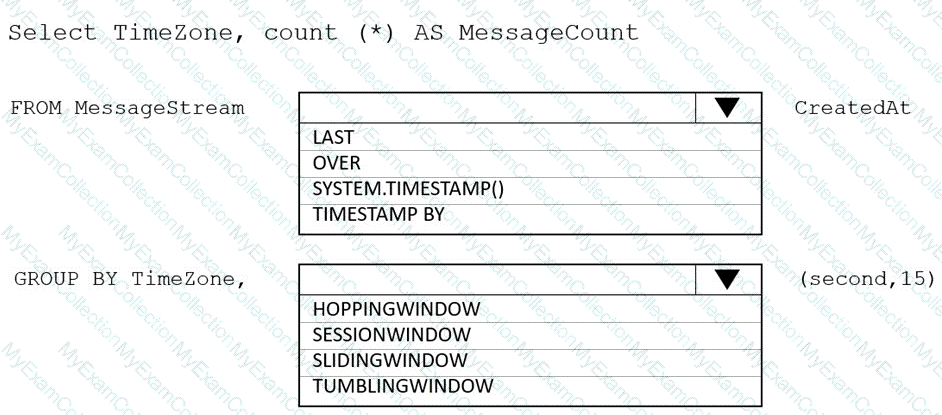
You plan to create an Azure Data Factory pipeline that will include a mapping data flow.
You have JSON data containing objects that have nested arrays.
You need to transform the JSON-formatted data into a tabular dataset. The dataset must have one tow for each item in the arrays.
Which transformation method should you use in the mapping data flow?
You have an Azure Data Lake Storage account that contains CSV files. The CSV files contain sales order data and are partitioned by using the following format.
/data/salesorders/year=xxxx/month-y
You need to retrieve only the sales orders from January 2023 and February 2023.
How should you complete the query? To answer, select the appropriate options in the answer area.
NOTE: Each correct selection is worth one point.
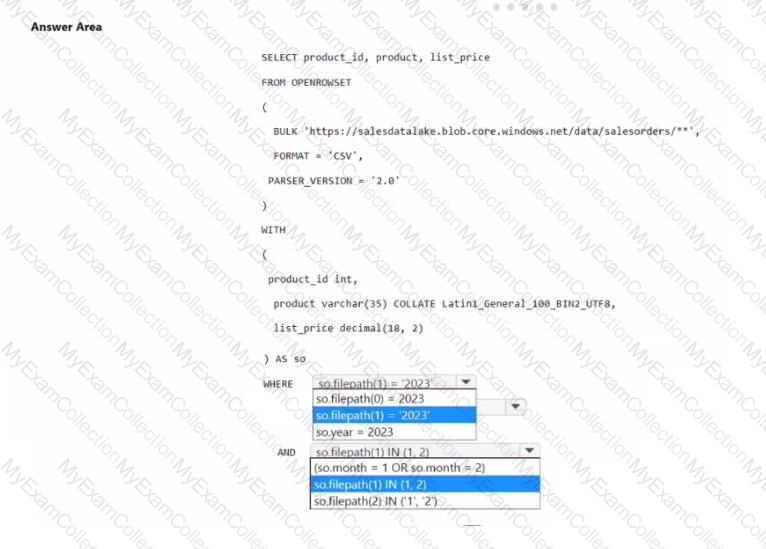
You have an Azure Synapse Analytics dedicated SQL pool named Pool1. Pool1 contains a table named table1.
You load 5 TB of data intotable1.
You need to ensure that columnstore compression is maximized for table1.
Which statement should you execute?
You have an Azure subscription that contains an Azure Synapse Analytics dedicated SQL pool named Pool1. Pool1 receives new data once every 24 hours.
You have the following function.
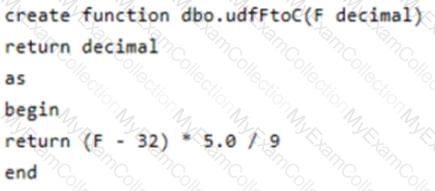
You have the following query.

The query is executed once every 15 minutes and the @parameter value is set to the current date.
You need to minimize the time it takes for the query to return results.
Which two actions should you perform? Each correct answer presents part of the solution.
NOTE: Each correct selection is worth one point.
Note: This question is part of a series of questions that present the same scenario. Each question in the series contains a unique solution that might meet the stated goals. Some question sets might have more than one correct solution, while others might not have a correct solution.
After you answer a question in this section, you will NOT be able to return to it. As a result, these questions will not appear in the review screen.
You are designing an Azure Stream Analytics solution that will analyze Twitter data.
You need to count the tweets in each 10-second window. The solution must ensure that each tweet is counted only once.
Solution: You use a tumbling window, and you set the window size to 10 seconds.
Does this meet the goal?
You have two fact tables named Flight and Weather. Queries targeting the tables will be based on the join between the following columns.
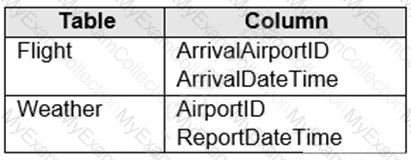
You need to recommend a solution that maximizes query performance.
What should you include in the recommendation?
You have an Azure Data Factory instance that contains two pipelines named Pipeline1 and Pipeline2.
Pipeline1 has the activities shown in the following exhibit.

Pipeline2 has the activities shown in the following exhibit.

You execute Pipeline2, and Stored procedure1 in Pipeline1 fails.
What is the status of the pipeline runs?
You have an Azure Synapse Analytics dedicated SQL pool that contains a large fact table. The table contains 50 columns and 5 billion rows and is a heap.
Most queries against the table aggregate values from approximately 100 million rows and return only two columns.
You discover that the queries against the fact table are very slow.
Which type of index should you add to provide the fastest query times?
You have an Azure Data Lake Storage Gen2 account that contains a container named container1. You have an Azure Synapse Analytics serverless SQL pool that contains a native external table named dbo.Table1. The source data for dbo.Table1 is stored in container1. The folder structure of container1 is shown in the following exhibit.
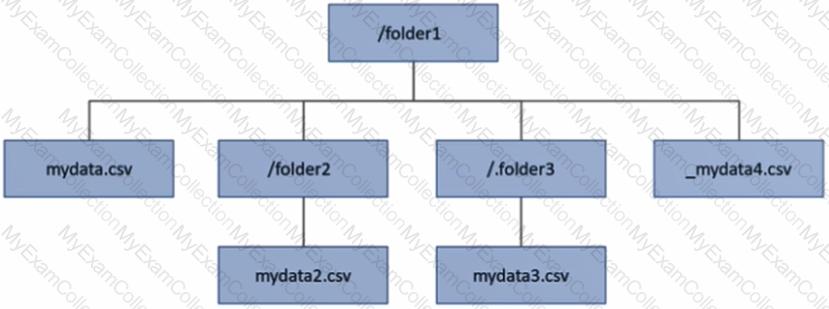
The external data source is defined by using the following statement.

For each of the following statements, select Yes if the statement is true. Otherwise, select No.
NOTE: Each correct selection is worth one point.

You need to implement an Azure Databricks cluster that automatically connects to Azure Data Lake Storage Gen2 by using Azure Active Directory (Azure AD) integration.
How should you configure the new cluster? To answer, select the appropriate options in the answer area.
NOTE: Each correct selection is worth one point.
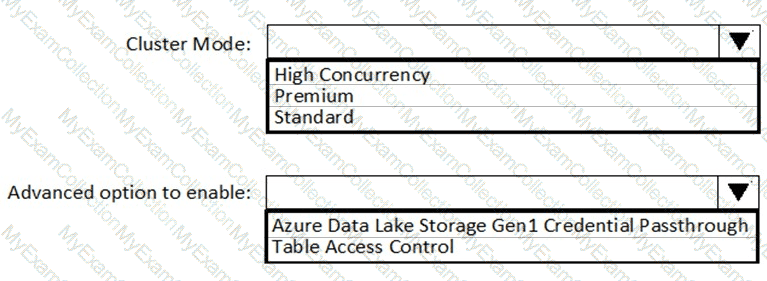
You are designing an application that will use an Azure Data Lake Storage Gen 2 account to store petabytes of license plate photos from toll booths. The account will use zone-redundant storage (ZRS).
You identify the following usage patterns:
• The data will be accessed several times a day during the first 30 days after the data is created. The data must meet an availability SU of 99.9%.
• After 90 days, the data will be accessed infrequently but must be available within 30 seconds.
• After 365 days, the data will be accessed infrequently but must be available within five minutes.
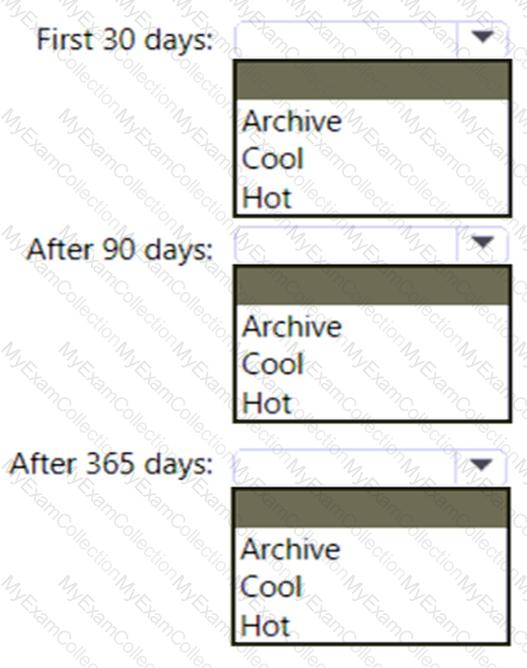
You have data stored in thousands of CSV files in Azure Data Lake Storage Gen2. Each file has a header row followed by a properly formatted carriage return (/r) and line feed (/n).
You are implementing a pattern that batch loads the files daily into an enterprise data warehouse in Azure Synapse Analytics by using PolyBase.
You need to skip the header row when you import the files into the data warehouse. Before building the loading pattern, you need to prepare the required database objects in Azure Synapse Analytics.
Which three actions should you perform in sequence? To answer, move the appropriate actions from the list of actions to the answer area and arrange them in the correct order.
NOTE: Each correct selection is worth one point
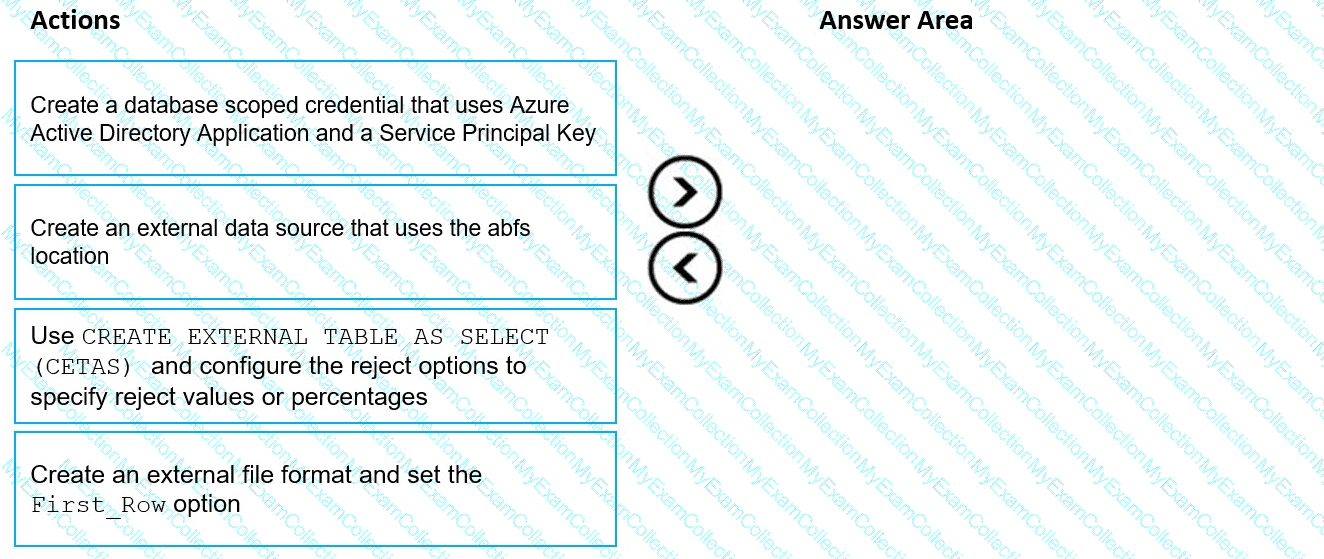
You have an Azure data solution that contains an enterprise data warehouse in Azure Synapse Analytics named DW1.
Several users execute ad hoc queries to DW1 concurrently.
You regularly perform automated data loads to DW1.
You need to ensure that the automated data loads have enough memory available to complete quickly and successfully when the adhoc queries run.
What should you do?
You need to design an analytical storage solution for the transactional data. The solution must meet the sales transaction dataset requirements.
What should you include in the solution? To answer, select the appropriate options in the answer area.
NOTE: Each correct selection is worth one point.
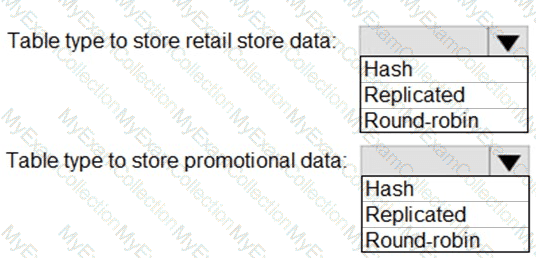
You need to design a data storage structure for the product sales transactions. The solution must meet the sales transaction dataset requirements.
What should you include in the solution? To answer, select the appropriate options in the answer area.
NOTE: Each correct selection is worth one point.

You need to implement the surrogate key for the retail store table. The solution must meet the sales transaction
dataset requirements.
What should you create?
You need to implement versioned changes to the integration pipelines. The solution must meet the data integration requirements.
In which order should you perform the actions? To answer, move all actions from the list of actions to the answer area and arrange them in the correct order.
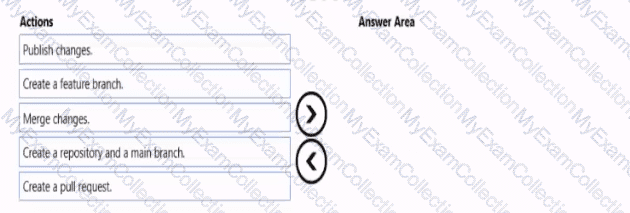
You need to design a data ingestion and storage solution for the Twitter feeds. The solution must meet the customer sentiment analytics requirements.
What should you include in the solution? To answer, select the appropriate options in the answer area
NOTE: Each correct selection b worth one point.

You need to integrate the on-premises data sources and Azure Synapse Analytics. The solution must meet the data integration requirements.
Which type of integration runtime should you use?
You need to design the partitions for the product sales transactions. The solution must meet the sales transaction dataset requirements.
What should you include in the solution? To answer, select the appropriate options in the answer area.
NOTE: Each correct selection is worth one point.
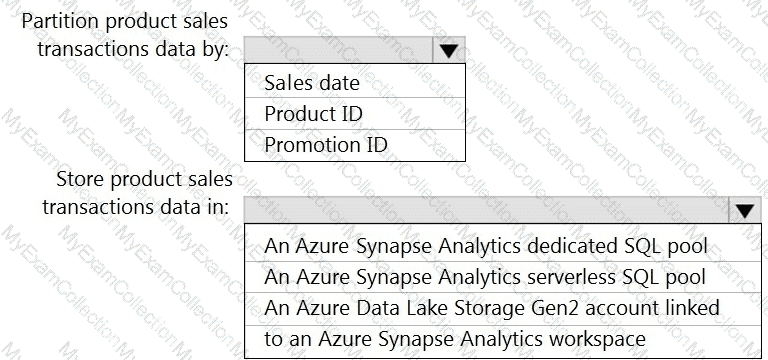
You need to ensure that the Twitter feed data can be analyzed in the dedicated SQL pool. The solution must meet the customer sentiment analytics requirements.
Which three Transaction-SQL DDL commands should you run in sequence? To answer, move the appropriate commands from the list of commands to the answer area and arrange them in the correct order.
NOTE: More than one order of answer choices is correct. You will receive credit for any of the correct orders you select.

You need to design a data retention solution for the Twitter feed data records. The solution must meet the customer sentiment analytics requirements.
Which Azure Storage functionality should you include in the solution?
You need to implement an Azure Synapse Analytics database object for storing the sales transactions data. The solution must meet the sales transaction dataset requirements.
What solution must meet the sales transaction dataset requirements.
What should you do? To answer, select the appropriate options in the answer area.
NOTE: Each correct selection is worth one point.

Which Azure Data Factory components should you recommend using together to import the daily inventory data from the SQL server to Azure Data Lake Storage? To answer, select the appropriate options in the answer area.
NOTE: Each correct selection is worth one point.
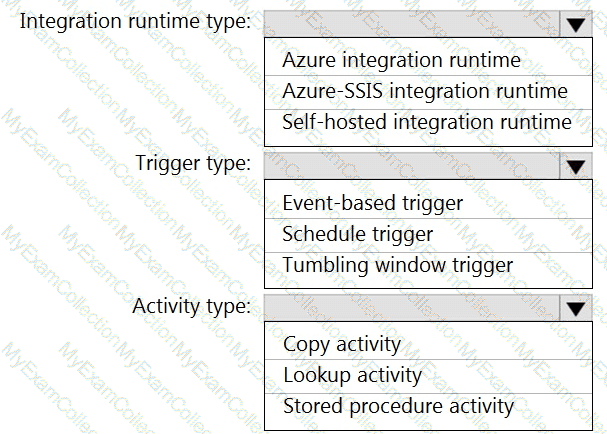
What should you do to improve high availability of the real-time data processing solution?
What should you recommend to prevent users outside the Litware on-premises network from accessing the analytical data store?
What should you recommend using to secure sensitive customer contact information?
































